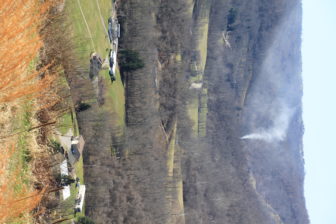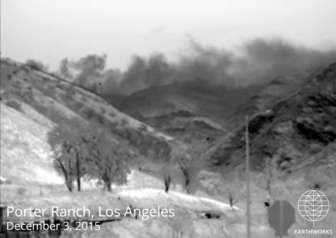Leann Leiter co-authored this blog with Pete Dronkers.
California sets an important precedent by forcing a major polluter to pay for some of the damage it caused after the infamous Aliso Canyon gas storage leak. Other states whose oil and gas operators likewise emit huge quantities of the methane that fuels climate change and air toxics that harm health could–and should–follow suit. Will they?
In the fall of 2015, a massive natural gas leak sprung deep underground at the Aliso Canyon gas storage facility in southern California, in the residential community of Porter Ranch. At its peak, about 110,000 pounds per hour of methane was escaping from the storage facility, causing hundreds of families to evacuate due to health concerns.
I had the chance to to document the emissions both from the ground and, for the first time, from the air, using an infrared optical gas imaging camera (FLIR camera). Not long after these images hit the press, Governor Brown declared a state of emergency, and the footage garnered over a million views on Youtube. The Aliso Canyon leak was already a major public and environmental emergency, but these images of otherwise invisible pollution made the true magnitude of the problem comprehensible. OGI videos showed gas traveling down the mountain and right over people’s homes. The leak continued for four months until a relief well was completed to intercept the pressure.
Although this was the biggest natural gas leak in US history, and undoubtedly the most heavily publicized, it was by no means the first. The lead author of a national study of underground gas storage indicated Aliso Canyon was only one of 200 releases from such facilities nationwide. Gas wells blow out frequently, as do storage facilities, polluting the air with millions of pounds of methane and other volatile organic compounds (VOCs), with consequences for health, air and water quality, and the climate. Even though I work on oil and gas issues, I can no longer keep track of how many reports I’ve read of blowouts, some of which have killed industry workers and residents.
In addition to the dangers and impacts to anyone working at or living near these sites, they represent some of the worst climate offenders out there. This is because over a 20 year timeframe, methane is 99 times more powerful of a greenhouse gas than carbon dioxide. For the duration of the Aliso Canyon blowout, that single source increased California’s total annual methane emissions by about 25%, and that’s in a state with a population of nearly 40 million people, close to 15 million cars, and an active oil industry.
In August of this year, So Cal Gas — the operator of the Aliso Canyon storage facility — and local, regional, and state governments reached a $119 million settlement to compensate for some of the damage done by the leak. One of the purposes of the settlement is to fund projects that would reduce greenhouse gas emissions elsewhere in the state — including the installation of methane digesters at dairy farms that capture and generate electricity from cattle waste and keep it out of the atmosphere.
While nothing can reverse the damage done to the residents of Porter Ranch — and critiques aside of using the So Cal Gas settlement to bail out the dairy industry from their own emissions reductions mandate — there is tremendous value in the concept of making polluters pay for damage they’ve done to the global climate and to local communities.
I’m not suggesting that the Aliso settlement is perfect, it’s not. We join with the residents of Porter Ranch and neighboring communities calling for a fully-funded health impact study; for Aliso Canyon to be shut down, not given a new lease on life; and for California to reduce its dependence on risky facilities like Aliso Canyon.

The Powhatan Point disaster also released massive amounts of methane into the atmosphere. XTO’s initial estimate indicated the well emitted “100 million cubic feet per day of natural gas”–greater than the daily amounts emitted at Aliso Canyon, albeit over a shorter time. The US EPA and Ohio EPA monitored air for one day only before allowing an XTO-hired contractor to take over, using questionable sampling methods. So far, neither the Ohio EPA nor the Ohio Department of Natural Resources has shared any plans to hold Exxon’s fracking subsidiary XTO accountable for the environmental damage they caused, including harm to the climate.
Large-scale releases of methane aren’t limited to headline-grabbing disasters like Aliso Canyon and Powhatan Point. In the Permian Basin of southeast New Mexico and West Texas, for example, $1 million worth of natural gas is flared and vented — in other words, completely wasted — every single day. Oil and gas pollution such as this releases enormous amounts of methane, carbon dioxide, and air toxics to the atmosphere, benefits no one, and is part of the reason climate change is accelerating beyond most predictions.
The days of a free pass to polluters should come to a close. Decision makers should consider mandatory compensatory statutes and/or rules to make sure that if any company either deliberately or accidentally pollutes, they should be held accountable to offset the damage they do to our climate, health, and communities.

